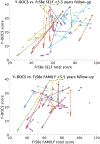Differential assessment of frontally-mediated behaviors between self- and informant-report in patients with obsessive-compulsive disorder following gamma ventral capsulotomy
- PMID: 35307368
- PMCID: PMC9231552
- DOI: 10.1016/j.neuropsychologia.2022.108211
Differential assessment of frontally-mediated behaviors between self- and informant-report in patients with obsessive-compulsive disorder following gamma ventral capsulotomy
Abstract
Obsessive-Compulsive Disorder (OCD) is a debilitating disorder causing marked distress and functional impairment. While advances in behavioral and pharmacotherapies have been effective for a majority of patients with OCD, 10-30% remain treatment refractory and severely impaired. For a subset of treatment-resistant individuals with the most severe and disabling (intractable) illness, gamma ventral capsulotomy (GVC) appears effective in reducing OCD symptoms and functional impairment. However, the effects of the ventral internal capsule lesion via GVC surgery on executive function in everyday life have been minimally investigated. Examining behavioral outcomes of GVC also provides a rare opportunity to probe the functional importance of the ventral prefrontal-subcortical connections of the internal capsule white matter tract in a relatively homogenous sample of patients with comparable white matter lesions. The present study investigated changes in frontally-mediated behaviors, measured by the Frontal Systems Behavior Scale (FrSBe), following GVC in 45 individuals with severe and otherwise intractable OCD, as rated by patients themselves and family members. Linear mixed effects models revealed a significant improvement in patient self-ratings on the FrSBe after surgery, while family ratings did not significantly change. Interestingly, improvement on the FrSBe for both self and family raters was significantly correlated with improvement in OCD symptomatology post-surgery, as measured by the Yale-Brown Obsessive Compulsive Scale (Y-BOCS). At the group level, we found no evidence of decline in frontally-mediated behaviors assessed by the FrSBe as a result of focal white matter disconnection via GVC. However, we cannot rule out the possibility that placebo effects or compromised patient self-awareness or insight contributed to the significant improvement in self ratings. Our measures may also have limited sensitivity to more selective impairments that could result from a small lesion to the ventral internal capsule. The present study demonstrates the need for detailed investigation of cognitive and behavioral changes as important factors when considering GVC as a viable treatment option for patients with refractory OCD.
Keywords: Executive function; Frontal lobe functions; Gamma ventral capsulotomy; Internal capsule lesion; Obsessive compulsive disorder; Ventromedial prefrontal cortex.
Published by Elsevier Ltd.
Conflict of interest statement
Figures






Similar articles
-
Gamma ventral capsulotomy for obsessive-compulsive disorder: a randomized clinical trial.JAMA Psychiatry. 2014 Sep;71(9):1066-76. doi: 10.1001/jamapsychiatry.2014.1193. JAMA Psychiatry. 2014. Retracted and republished in: JAMA Psychiatry. 2015 Dec;72(12):1258. doi: 10.1001/jamapsychiatry.2015.0673. PMID: 25054836 Retracted and republished. Clinical Trial.
-
An International Radiosurgery Research Foundation Multicenter Retrospective Study of Gamma Ventral Capsulotomy for Obsessive Compulsive Disorder.Neurosurgery. 2019 Dec 1;85(6):808-816. doi: 10.1093/neuros/nyy536. Neurosurgery. 2019. PMID: 30476294
-
A study of cognitive function in treatment-refractory obsessive-compulsive disorder treated with capsulotomy.J Neurosurg. 2018 Feb;128(2):583-595. doi: 10.3171/2016.9.JNS152494. Epub 2017 Mar 24. J Neurosurg. 2018. PMID: 28338440
-
Evolution of gamma knife capsulotomy for intractable obsessive-compulsive disorder.Mol Psychiatry. 2019 Feb;24(2):218-240. doi: 10.1038/s41380-018-0054-0. Epub 2018 May 9. Mol Psychiatry. 2019. PMID: 29743581 Free PMC article.
-
Deep brain stimulation versus anterior capsulotomy for obsessive-compulsive disorder: a review of the literature.J Neurosurg. 2015 May;122(5):1028-37. doi: 10.3171/2014.11.JNS132618. Epub 2015 Jan 30. J Neurosurg. 2015. PMID: 25635480 Review.
Cited by
-
Evidence Accumulation and Neural Correlates of Uncertainty in Obsessive-Compulsive Disorder.Biol Psychiatry Cogn Neurosci Neuroimaging. 2023 Oct;8(10):1058-1065. doi: 10.1016/j.bpsc.2023.05.011. Epub 2023 Jun 19. Biol Psychiatry Cogn Neurosci Neuroimaging. 2023. PMID: 37343660 Free PMC article.
-
Cognitive outcomes following functional neurosurgery in refractory OCD patients: a systematic review.Neurosurg Rev. 2023 Jun 23;46(1):145. doi: 10.1007/s10143-023-02037-w. Neurosurg Rev. 2023. PMID: 37351641 Free PMC article.
References
-
- American Psychiatric Association. (2013). Diagnostic and statistical manual of mental disorders (5 ed.). 10.1176/appi.books.9780890425596 - DOI
Publication types
MeSH terms
Grants and funding
LinkOut - more resources
Full Text Sources
Medical

